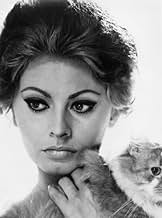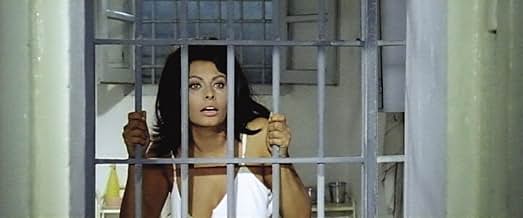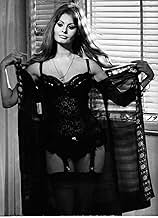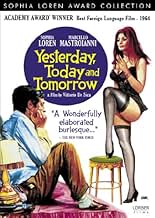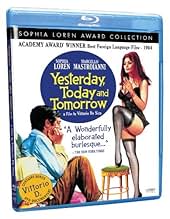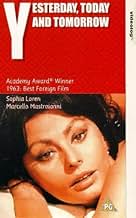IMDb RATING
7.2/10
11K
YOUR RATING
Stories about three very different women and the men they attract.Stories about three very different women and the men they attract.Stories about three very different women and the men they attract.
- Won 1 Oscar
- 8 wins & 3 nominations total
Tonino Cianci
- (segment "Adelina")
- (as Antonio Cianci)
Gianni Ridolfi
- Umberto (segment "Mara")
- (as Giovanni Ridolfi)
Featured reviews
Italian anthology comedy starring Sophia Loren and Marcello Mastroianni. It's often cited as one of the best films of both stars. There are three stories involving different couples, each played by Loren and Mastroianni. The first has Sophia as a wife who keeps getting pregnant to avoid a jail sentence. It's an amusing story, although it goes on a little long. The second story is about a rich married woman taking a drive with her lover. The segment is pretty dull as it builds up to its punchline. But I suppose that was the point, to make you thing this was an inane soap opera story about whether this woman will choose fortune or love. The question is answered humorously enough but this is still the weakest story in the film. The third story, and the one for which the movie is probably most famous, has Sophia playing a prostitute. Her neighbor's grandson, about to become a priest, falls for Sophia and she must try to set him back on the right path. But, in doing so, she makes a vow that frustrates lustful client Marcello. Sophia's never looked sexier than here and her striptease is legendary.
Of the three stories, the last is the most entertaining but none are bad. Sophia is beautiful and enchanting. She and Marcello are both fun in every segment. It's an enjoyable film, though probably much more so if you are a big fan of Italian cinema to begin with.
Of the three stories, the last is the most entertaining but none are bad. Sophia is beautiful and enchanting. She and Marcello are both fun in every segment. It's an enjoyable film, though probably much more so if you are a big fan of Italian cinema to begin with.
1963's "Yesterday, Today and Tomorrow" was, like the previous year's "Boccaccio 70," another anthology feature, this time featuring Sophia Loren with her most frequent leading man, Marcello Mastroianni, starring in all three stories for director Vittorio De Sica. In "Adelina" they are a married couple living in a poverty stricken section of Naples, where she must dodge arrest for nonpayment on furniture by way of pregnancy; "Anna" finds her a bored socialite wed to an often absent industrialist who ultimately chooses wealth over love to Mastroianni's disappointment; and in "Mara" she plays a high priced call girl who vows to spend a week without sex to convince the young man next door to follow the call of the priesthood. Her final reel striptease remains the stuff of legend but is quite tame today, the actress considering it a most pleasing, natural performance. As a 1963 Oscar winner as Best Foreign Film it was a huge success, with both stars reuniting with De Sica for their next picture, "Marriage Italian Style."
There is such a delightful playfulness to this trio of tales about relationships between men and women in Italy. Sophia Loren is in three different roles – a poor mother in Naples who keeps getting pregnant and having children to postpone being jailed for failing to pay debts on her furniture, a rich woman in Naples who has had a one-night stand while her husband is away at a conference and has picked him up the following day in her Rolls-Royce, and a high-class courtesan who does business out of her apartment overlooking Piazza Navone in Rome, attracting the attention of a young man studying to be a priest. I wouldn't say Loren has exceptional range, but she does turn in a solid performance, and plays feisty, haughty, seductive, angry, and bemused pretty well, all while being quite entertaining. Marcello Mastroianni is her counterpart in each tale (one of the clients in the last, not the young man), and is similarly engaging. It was nice to see him so light on his feet as he moved around in that last tale; his expressions were over-the-top (in a good way), and it was funny to see him ask Loren to dress up as a schoolgirl, and then watch her reaction.
The movie feels quintessentially Italian, as the characters are animated and highly expressive. There is also a feeling of genuine humanity and community. There is an honesty here, as each of the stories quite openly acknowledges sexual urges in both men and women as being natural and a positive thing, which is quite refreshing. At the same time, it remains decent and acknowledges a sense of higher morality. In the first tale, Loren's character is tempted but does not sleep with her brother-in-law when her husband can't get her pregnant again, accepts going to jail, and talks to the prisoners there without an ounce of judgment about why they're there. In the second, Mastroianni's character realizes how shallow Loren's is when she's more concerned about damage to her car after they nearly run over a child. In the third, Loren's character realizes that despite an antagonistic relationship with the young man's grandmother (played fantastically by Tina Pica), she has common ground with her, and must persuade the boy to stay on his path. How nice it is that director Vittorio De Sica shows us that these things – lust and morality – can exist side by side, perfectly well.
The movie feels quintessentially Italian, as the characters are animated and highly expressive. There is also a feeling of genuine humanity and community. There is an honesty here, as each of the stories quite openly acknowledges sexual urges in both men and women as being natural and a positive thing, which is quite refreshing. At the same time, it remains decent and acknowledges a sense of higher morality. In the first tale, Loren's character is tempted but does not sleep with her brother-in-law when her husband can't get her pregnant again, accepts going to jail, and talks to the prisoners there without an ounce of judgment about why they're there. In the second, Mastroianni's character realizes how shallow Loren's is when she's more concerned about damage to her car after they nearly run over a child. In the third, Loren's character realizes that despite an antagonistic relationship with the young man's grandmother (played fantastically by Tina Pica), she has common ground with her, and must persuade the boy to stay on his path. How nice it is that director Vittorio De Sica shows us that these things – lust and morality – can exist side by side, perfectly well.
This very enjoyable film may be a let down for someone expecting the heights of De Sica's Neorealist masterpieces like The Bicycle Thief or Two Women. However it is very funny in parts and is pointedly critical of Italian society in the boom years of the 1960s. Also Sophia Loren and Marcello Mastroianni are absolutely stunning to watch.
For people interested in Italy it is a fascinating commentary on the country that can border on stereotype. Naples (De Sica's hometown) is warm and happy and filled with clever types ready to outwit the system and find their own way to happiness. Milan is cold, rich, and callous. Rome is dominated by the Catholic church and the State with plenty of hypocrisy and corruption. But De Sica finds some humor in all of this.
I found it a little too sentimental but well worth watching. I wish a better (undubbed) print were available. De Sica's career was given a boost by the success of the movie and he would continue to make more great films like The Garden of the Finzi-Contini's and the underrated A Brief Vacation that focus on the injustices of the State and the hardships faced by working people.
For people interested in Italy it is a fascinating commentary on the country that can border on stereotype. Naples (De Sica's hometown) is warm and happy and filled with clever types ready to outwit the system and find their own way to happiness. Milan is cold, rich, and callous. Rome is dominated by the Catholic church and the State with plenty of hypocrisy and corruption. But De Sica finds some humor in all of this.
I found it a little too sentimental but well worth watching. I wish a better (undubbed) print were available. De Sica's career was given a boost by the success of the movie and he would continue to make more great films like The Garden of the Finzi-Contini's and the underrated A Brief Vacation that focus on the injustices of the State and the hardships faced by working people.
YESTERDAY, TODAY AND TOMORROW is a romantic comedy, which consists of three stories set in different parts of Italy. All three stories are framed in a romantic farce, which examines relationships through common life issues, such as poverty, adultery, sex and religion.
Stories about three very different women and the men they attract.
Adelina sells black-market cigarettes in Naples. Her husband is unemployed. She tries to avoid a jail sentence at any cost.
In Milan, Anna drives a Rolls, is bored, and picks up a writer, who is her lover. She talks dreamily of running off with him until he dents her car. After that, she shows her true face.
Mara, who works as a prostitute from her apartment in Rome, turns the head of a naive seminarian. After talking with his grandmother, she wants to help a young man, while her nervous client from Bologna impatiently waiting.
A male protagonist is exposed to tragicomic sobering, while a female protagonist is in a kind of inner conflicts, in each of the three stories. That's the point. The different characters of people are exposed to very strange situations, through which they question their relationships.
The scenery is very impressive, especially in the first story. That Neapolitan atmosphere in explosion of colors in a narrow streets is truly remarkable. The dialogues are, here and there, trivial and empty. Humor is somewhat forced, but it's pretty luscious. Characterization is not bad at all.
Sophia Loren (Adelina Sbaratti, Anna Molteni and Mara) is a temperamental and brave housewife, an elegant and selfish rich woman and a sensitive prostitute who would talk about morality. Yes, Ms. Loren looks divine in each of these women.
Marcello Mastroianni (Carmine Sbaratti, Renzo and Augusto Rusconi) is a fertile, but useless husband, a cautious lover and an impatient client, who can not accept the fact that he's in love with a beautiful prostitute. Mr. Mastroianni is mostly a muddled and confused character in each of the three stories.
I will say that this is another successful commedia all'italiana
Stories about three very different women and the men they attract.
Adelina sells black-market cigarettes in Naples. Her husband is unemployed. She tries to avoid a jail sentence at any cost.
In Milan, Anna drives a Rolls, is bored, and picks up a writer, who is her lover. She talks dreamily of running off with him until he dents her car. After that, she shows her true face.
Mara, who works as a prostitute from her apartment in Rome, turns the head of a naive seminarian. After talking with his grandmother, she wants to help a young man, while her nervous client from Bologna impatiently waiting.
A male protagonist is exposed to tragicomic sobering, while a female protagonist is in a kind of inner conflicts, in each of the three stories. That's the point. The different characters of people are exposed to very strange situations, through which they question their relationships.
The scenery is very impressive, especially in the first story. That Neapolitan atmosphere in explosion of colors in a narrow streets is truly remarkable. The dialogues are, here and there, trivial and empty. Humor is somewhat forced, but it's pretty luscious. Characterization is not bad at all.
Sophia Loren (Adelina Sbaratti, Anna Molteni and Mara) is a temperamental and brave housewife, an elegant and selfish rich woman and a sensitive prostitute who would talk about morality. Yes, Ms. Loren looks divine in each of these women.
Marcello Mastroianni (Carmine Sbaratti, Renzo and Augusto Rusconi) is a fertile, but useless husband, a cautious lover and an impatient client, who can not accept the fact that he's in love with a beautiful prostitute. Mr. Mastroianni is mostly a muddled and confused character in each of the three stories.
I will say that this is another successful commedia all'italiana
Did you know
- TriviaThe red car that picks up Mara after the accident is an extremely rare 1960 Ferrari 250 GT California Spyder SWB. Only 56 of these cars were made and some have sold for over $10M at auction in the 2010's.
- GoofsAs Anna and Renzo talk while driving, the windshield of her Rolls-Royce Silver Cloud II shakes because the little side windows are gone, but the little side windows are intact in the wide shots.
- Quotes
Carmine Sbaratti: The people of Forcella are out of this world. They've risen up in a gesture of solidarity!
Verace's sister: I must say, it almost makes you forget how filthy and ignorant they are.
- ConnectionsEdited into Marcello, una vita dolce (2006)
Details
- Release date
- Countries of origin
- Language
- Also known as
- Yesterday, Today and Tomorrow
- Filming locations
- Piazza Navona, Rome, Lazio, Italy(3rd part - Mara's apartment)
- Production companies
- See more company credits at IMDbPro
- Runtime
- 1h 58m(118 min)
- Sound mix
- Aspect ratio
- 2.35 : 1
Contribute to this page
Suggest an edit or add missing content


